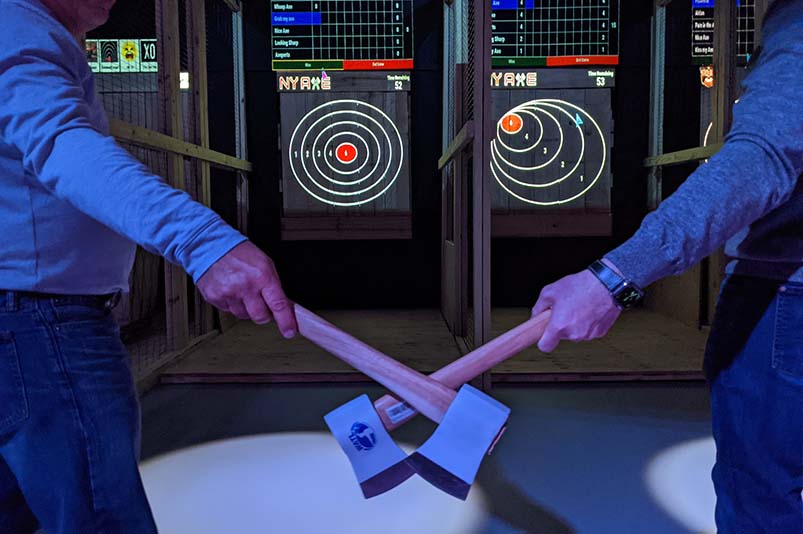The Fun of Axe Throwing: How This Sporting Activity Combines Ability and Adrenaline for a Fun Time
Axe throwing has actually emerged as an astounding sporting activity that masterfully links the need for accurate skill with the thrill of adrenaline, offering individuals a special and engaging experience. The act of hurling an axe towards a target requires concentration and technique, concurrently promoting an environment of friendship and pleasant rivalry.
The Beginnings of Axe Throwing
Axe tossing, a recreational activity that has gotten significant popularity in current years, traces its origins back to ancient times. The earliest records of axe usage in competitive contexts are discovered among the Celts and Vikings, that threw axes for sport as well as in fight training.
Medieval European warriors, specifically during the Middle Ages, exercised axe tossing as component of their martial training. The Francisca, a sort of tossing axe utilized by the Franks, became legendary for its fatal accuracy. This traditional weapon was made to be tossed at enemy shields and armor, showcasing its dual energy in both sporting activity and battle.
In even more recent background, axe throwing saw a revival in the logging camps of The United States and copyright in the 19th and 20th centuries. Lumberjacks would engage in pleasant competitors, examining their accuracy and strength by intending at wooden targets. This advancement from a survival skill to a leisure task has actually paved the way for its modern-day rebirth, with specialized places and leagues now commemorating the sport internationally.
Tools You Need
Comprehending the abundant background of axe tossing enhances the gratitude of the sporting activity's modern-day model. Central to this thrilling activity is the tools, which is crucial for both safety and security and efficiency. The key device is, obviously, the axe. For entertainment and affordable axe tossing, one of the most commonly used type is the hatchet, generally weighing between 1.25 to 2 extra pounds with a manage size of around 16 inches. The axe ought to have a sharp, properly maintained blade and a manage made from long lasting wood or composite material, guaranteeing a good hold and balance.
Equally important is the target. Policy targets are created from wood, with softwood varieties like yearn or cottonwood being chosen for their ability to hold the axe and take in. The target is usually separated into 5 concentric circles, each with a details point value, to help with rating.
Security equipment, though often forgotten, is important. Safety handwear covers can improve grasp and stop sores, while closed-toed footwear are a must to safeguard feet from dropped axes (axe throwing denver). Finally, a well-lit, large throwing area, full with safety and security obstacles, ensures a controlled setting where participants can concentrate on honing their skills.
Standard Techniques Discussed
Grasping the basic methods of axe throwing is crucial for both safety and efficiency. The leading hand should be placed straight below the axe head, while the non-dominant hand supports the end of the handle.
Following, concentrate on the position. Stand with your feet shoulder-width apart, ensuring your body is balanced. Your dominant foot should be slightly ahead, aligning with your target. This positioning help in maintaining security and routing power properly towards the target.

Security First
Making sure security in axe throwing is extremely important to creating an injury-free and enjoyable experience. Precaution begin with the location format. A well-designed axe throwing center attributes clear demarcations in between tossing lanes, tough backgrounds to catch stray axes, and non-slip flooring to prevent crashes. Additionally, ample lighting is crucial to help participants maintain aesthetic accuracy and spatial awareness.
Benefits of Axe Throwing
Axe throwing offers a myriad of benefits that prolong beyond basic recreation. Physically, it provides a full-body workout, involving muscle mass in the arms, shoulders, back, and core. The repeated activity of throwing the axe likewise boosts hand-eye coordination and great electric motor skills. For those aiming to enhance their total health and fitness, axe throwing can offer as a appealing and dynamic type of exercise.
Emotionally, axe tossing needs accuracy, method, and focus, making it an exceptional way to hone cognitive abilities. The concentration required to strike the target can work as a form of mindfulness, permitting individuals to remove their minds and reduce stress. This psychological interaction can be especially helpful in helping people establish far better problem-solving skills and psychological strength.
Socially, axe throwing is frequently enjoyed in group setups, cultivating team-building and friendship. Whether as component of a business occasion or a laid-back trip with friends, the sporting activity motivates communication and collaboration. Furthermore, the communal experience of finding out and improving together can reinforce relationships go to the website and produce long lasting memories.
Verdict

The earliest records of axe usage in affordable contexts are found among the Celts and Vikings, that tossed axes for sport as well as in battle training. Launch the axe when your hands are roughly at eye degree, permitting the axe's all-natural turning to assist it towards the target.
A well-designed axe throwing facility functions clear separations in between tossing lanes, tough backgrounds to catch stray axes, and non-slip flooring to prevent mishaps. Participants need to be advised on the appropriate means to take care of and toss the axe, highlighting managed, intentional activities over forceful throws.
In summary, axe throwing stands out as a sporting activity that masterfully incorporates adrenaline, skill, and precision.